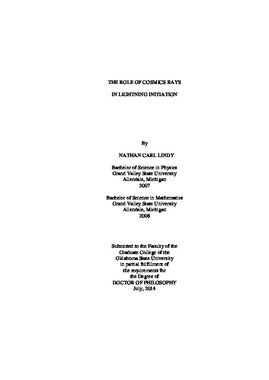| dc.contributor.advisor | Benton, Eric R. | |
| dc.contributor.author | Lindy, Nathan Carl | |
| dc.date.accessioned | 2015-06-17T20:06:46Z | |
| dc.date.available | 2015-06-17T20:06:46Z | |
| dc.date.issued | 2014-07 | |
| dc.identifier.uri | https://hdl.handle.net/11244/14971 | |
| dc.description.abstract | From electric field measurements, the maximum electric fields typically found within a thunderstorm are an order of magnitude too weak to initiate a lightning discharge. Relativistic electrons produced in galactic cosmic ray (GCR) extensive air showers (EAS) in the atmosphere have been theorized to be accelerated in thunderstorm electric fields and initiate long lived Relativistic Runaway Electron Avalanches (RREA). RREAs produce an increasing number of high energy secondary electrons, which also initiate further RREAs. The RREA and hybrid lightning initiation models propose that RREAs produced in thunderstorm electric fields are able to initiate lightning discharges. The RREA model proposes that RREAs produce a sufficient number of high energy secondary electrons to generate a lightning discharge. The hybrid model proposes that the RREAs ionize the atmosphere and generate a plasma of low energy electrons that enhances the thunderstorm electric field sufficiently to that a lightning discharge can be initiated by hydrometeors. Using the Monte Carlo code CORSIKA 6.790, the fair weather EAS secondary electron environment has been simulated and has been found to have a maximum secondary electron density of ~10^5</super. >1 MeV secondary electrons m-2 and includes >1 GeV secondary electrons at an altitude of 6 km. This population of secondary electrons was then propagated through a measured thunderstorm vertical electric field profile to determine if there are a sufficient number of secondary electrons to initiate a lightning discharge according to both the RREA and hybrid models. There was not a sufficient numbers of secondary electrons for either model to initiate a lightning discharge, but the hybrid model only required an order of magnitude increase in the number of electrons in order to initiate a lightning discharge compared to the ten orders of magnitude required by the RREA model. By combining the data from a ground based cosmic ray muon detector array and the Oklahoma Lightning Mapping Array, it was found that at >90% confidence level, that lightning initiations within 1 km of the cosmic ray detector array were preceded by the passage of an EAS through the thunderstorm. | |
| dc.format | application/pdf | |
| dc.language | en_US | |
| dc.rights | Copyright is held by the author who has granted the Oklahoma State University Library the non-exclusive right to share this material in its institutional repository. Contact Digital Library Services at lib-dls@okstate.edu or 405-744-9161 for the permission policy on the use, reproduction or distribution of this material. | |
| dc.title | Role of cosmic rays in lightning initiation | |
| dc.contributor.committeeMember | Borunda, Mario F. | |
| dc.contributor.committeeMember | Mintmire, John W. | |
| dc.contributor.committeeMember | Elshahed, Mostafa S. | |
| osu.filename | Lindy_okstate_0664D_13500.pdf | |
| osu.accesstype | Open Access | |
| dc.type.genre | Dissertation | |
| dc.type.material | Text | |
| dc.subject.keywords | corsika | |
| dc.subject.keywords | galactic cosmic rays | |
| dc.subject.keywords | lightning initiation | |
| dc.subject.keywords | relativistic runaway electron avalanche | |
| thesis.degree.discipline | Physics | |
| thesis.degree.grantor | Oklahoma State University | |
